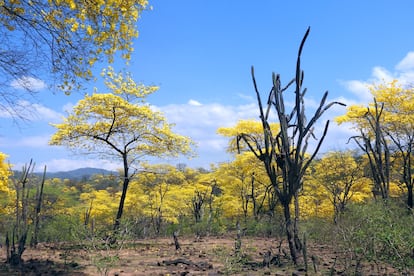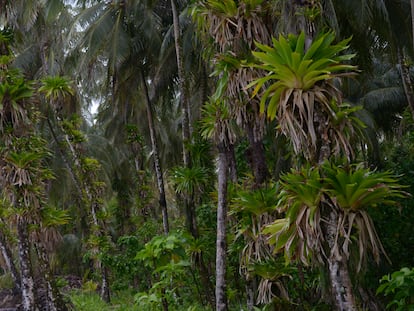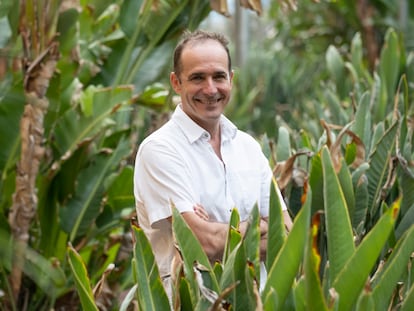Arid areas have as much diversity as jungles and forests
A new study has found that species surviving under some of the most extreme conditions on the planet are ‘functionally hyperdiverse’
Even the dictionary associates aridity with sterility and barrenness. But this is a human invention, as demonstrated by the existence of millions and millions of plants hidden in the deserts. The reality in nature is that the trait diversity of plants in arid zones is twice as imaginative as that of plants in more humid regions. A study by a hundred scientists published in the prestigious journal Nature, with data from hundreds of species from the driest regions of the planet, has revealed that the variety of forms, solutions and responses of plants in these extreme conditions far exceeds that of species in humid areas.
“Alicante [an arid zone in Spain] has a greater diversity of species than the whole of the United Kingdom put together,” says Fernando Maestre, a researcher from the King Abdullah University of Science and Technology in Saudi Arabia. Considered one of the world’s leading experts on arid zones, Maestre is co-author of this myth-busting research. He is quick to clarify that the aim of the work was not to quantify whether there were more or fewer species in dry zones, but rather to quantify their functional variety, their traits. To do this, the researchers analyzed up to 20 different traits, from the shape of plant leaves to their volume. The team also looked at the elemental concentration in plant leaves, known as the plant elementome. This trait diversity exceeds that observed in humid areas of the planet, particularly those in temperate zones.
The results of the work, based on samples from hundreds of species from deserts and arid zones (both hot and cold climates), are summed up by Nicolas Gross, a French biologist from the University of Clermont Auvergne/INRAE: “Our study basically says that if you randomly select two species in an arid environment, they will be much more different in their form and in their function than two species selected in a more temperate climate.” It is true that in the arid regions — zones that receive less than 400 mm of rainfall per year — there is a significant fall in vegetation cover and species richness and large areas of bare soil is seen. But, as Gross adds, “these plant species present surprising differences in their morphological and physiological traits, which means that these extreme environments are functionally hyperdiverse.”
As genera such as cacti and succulents show, the variety of responses to aridity is greater than that displayed in humid conditions. In addition to formal diversity, they also display greater elementome diversity. Faced with a shortage of water and macronutrients such as nitrogen, plants in arid zones use a highly diverse combinations of other minerals, such as iron, zinc, sodium or potassium. For example, some have developed high levels of calcium, which strengthens cell walls as protection against desiccation. Others contain high concentrations of salt, which reduces transpiration.
“Esparto grass, which we have taken samples from in the Iberian Peninsula, as well as from Morocco to Libya, has very folded leaves. This protects its stomata, the holes it opens to capture CO₂, but through which it also loses water vapor,” recalls Maestre. But everything in the design of this plant, which has been used for thousands of years, is designed to take advantage of the little water available and to reduce evapotranspiration. “It takes advantage of any pulse of water to carry out photosynthesis,” he adds. And, if that were not enough, “it is not very palatable due to its high carbon and fiber content, which makes it unappetising to herbivores; goats and sheep only eat it when they have nothing else,” adds the Spanish scientist.

Another discovery of this work is that arid plants have a greater diversity of shapes, sizes and functions when there is more aridity. It was assumed that, under extreme conditions, the trend would be towards simplification — in other words, that aridity would reduce plant diversity through selection, leaving only those species capable of tolerating extreme water scarcity and thermal stress. But the findings forced the researchers to discard this hypothesis and opt for another: they saw that trait diversity increases abruptly and non-linearly below the threshold of 400 mm of annual rainfall. To explain this phenomenon, the authors of the study suggest that the loss of vegetation cover leads to what they call plant loneliness syndrome.
“These lonely plants are those that exhibit a unique set of morphological, chemical and physiological traits that make them functionally unique,” explains Gross. His hypothesis is that these unusual plants can persist in an arid environment because they escape from more competitive species that can be found in more productive climatic conditions. “That is what we call plant loneliness syndrome, where scattered vegetation in the most arid dryland landscapes exhibit a high degree of trait uniqueness. If you think of dryland plant species such as cacti, baobabs, euphorbia... we can all bring to mind some images of strange dryland plants.”
For the researchers, this wealth of responses from arid zone vegetation will be key to addressing climate change and the advance of global desertification and aridification. That’s why they believe it was important to globally quantify for the first time the trait diversity of arid plants around the world.
“It was a critical gap, since most of the data we have today on the diversity of plant traits comes from domestic plants and wild plant species from more temperate climates, and this is despite the fact that drylands cover 45% of land areas,” says Gross.
“Many arid regions are very inhospitable, few people live there, they were inaccessible, they have been little studied,” adds Maestre.
The lack of agricultural or extractive interest in arid areas also explains why this field of research had been overlooked. “Traditionally, they have been considered to be of little value. If you ask someone about biodiversity, they will talk about the Amazon rainforest or a Swiss meadow, when that is not the case,” says Maestre.
Sign up for our weekly newsletter to get more English-language news coverage from EL PAÍS USA Edition
Tu suscripción se está usando en otro dispositivo
¿Quieres añadir otro usuario a tu suscripción?
Si continúas leyendo en este dispositivo, no se podrá leer en el otro.
FlechaTu suscripción se está usando en otro dispositivo y solo puedes acceder a EL PAÍS desde un dispositivo a la vez.
Si quieres compartir tu cuenta, cambia tu suscripción a la modalidad Premium, así podrás añadir otro usuario. Cada uno accederá con su propia cuenta de email, lo que os permitirá personalizar vuestra experiencia en EL PAÍS.
¿Tienes una suscripción de empresa? Accede aquí para contratar más cuentas.
En el caso de no saber quién está usando tu cuenta, te recomendamos cambiar tu contraseña aquí.
Si decides continuar compartiendo tu cuenta, este mensaje se mostrará en tu dispositivo y en el de la otra persona que está usando tu cuenta de forma indefinida, afectando a tu experiencia de lectura. Puedes consultar aquí los términos y condiciones de la suscripción digital.
More information
Archived In
Últimas noticias
Sinaloa Cartel war is taking its toll on Los Chapitos
Venezuela hardens its ‘revolutionary state’ project amid pressure from Trump
Sydney Sweeney, the actress praised by Trump: ‘Women are up against what society wants them to be’
The Bolsonaro surname: An advantage or liability in Brazil’s 2026 presidential elections?
Most viewed
- Reinhard Genzel, Nobel laureate in physics: ‘One-minute videos will never give you the truth’
- Pablo Escobar’s hippos: A serious environmental problem, 40 years on
- Charles Dubouloz, mountaineering star, retires at 36 with a farewell tour inspired by Walter Bonatti
- Why we lost the habit of sleeping in two segments and how that changed our sense of time
- The fall of a prolific science journal exposes the billion-dollar profits of scientific publishing











































